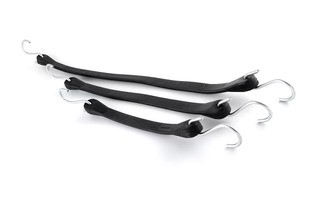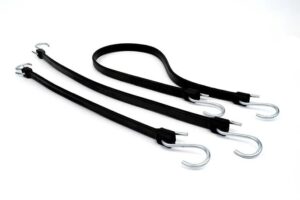When securing tarps for various applications, tarp straps are essential tools that provide both durability and reliability. They ensure that your tarps stay in place, regardless of the weather conditions. In this guide, we will cover everything you need to know about tarp straps, including their definition, selection criteria, practical applications, and personal insights from users who have successfully utilized these straps. Whether you’re a DIY enthusiast or a seasoned professional, this information will help you make the most of heavy duty rubber straps and rubber tarp straps.
Understanding Tarp Straps: What They Are and How They Work
 What Are Tarp Straps?
What Are Tarp Straps?
Tarp straps, often crafted from heavy-duty rubber, are elastic bands designed to secure tarps tightly over various objects or surfaces. They come in different lengths and thicknesses, allowing flexibility in use. Their primary function is to hold tarps in place, protecting items from moisture, wind, and debris.
How Do Tarp Straps Work?
Tarp straps function through tension. When stretched over a tarp, they create a snug fit that prevents flapping and movement. The rubber’s elasticity provides a strong grip, ensuring the tarp remains taut even in windy conditions. Here’s a closer look at their components:
Material: Most tarp straps consist of high-quality rubber, which offers strength and flexibility. These heavy-duty rubber straps withstand extreme weather and heavy loads.
Design: Tarp straps typically feature hooks on either end, allowing easy attachment to anchor points. These hooks may be S-shaped or designed for specific fittings, making them versatile for various applications.
Benefits of Using Tarp Straps
| Benefit | Description |
| Versatility | Tarp straps apply in numerous scenarios, from securing a tarp over a load in a truck to covering outdoor furniture. |
| Durability | Made from robust rubber, these straps resist wear and tear, ensuring long-lasting performance. |
| Ease of Use | With simple attachment methods, they are easy to handle, making them ideal for users of all skill levels. |
Choosing the Right Tarp Straps for Your Needs
Factors to Consider
When selecting tarp straps, consider these factors:
Length: Tarp straps come in various lengths. Depending on your tarp size and the distance between anchor points, you may need shorter or longer straps. Generally, lengths of 15 to 30 inches are standard for most applications.
Thickness: Strap thickness impacts load-bearing capacity. For heavy-duty tasks, choose thicker straps to ensure they endure weight and tension.
Hook Type: The type of hooks influences usability. S-hooks are common, but some straps have specialized hooks designed for specific tasks, like fitting into tie-down points or loops on tarps.
Material Quality: Look for straps made from high-quality rubber. Heavy-duty rubber straps tend to last longer and perform better in extreme conditions.
Types of Tarp Straps
- Standard Rubber Tarp Straps: Commonly used for general purposes.
- Heavy-Duty Rubber Straps: Designed for tough conditions and heavy loads, these straps provide extra strength and durability.
- Adjustable Tarp Straps: Some straps have adjustable features, allowing you to customize the tension as needed.
Recommended Products
Some reputable brands for tarp straps include:
- Keeper: Known for their heavy-duty rubber straps that are durable and versatile.
- Mytee Products: Offers a range of rubber tarp straps that are highly rated by users for their quality and reliability.
- CARGOLOC: Provides adjustable tarp straps that are great for securing various loads.
Pros and Cons:
– Keeper: Pros – durable and flexible. Cons – may be pricier than alternatives.
– Mytee Products: Pros – high elasticity. Cons – limited color options.
– CARGOLOC: Pros – adjustable tension. Cons – some users report hook weakness.
Where to Buy Tarp Straps
You can find tarp straps at various retail outlets, such as:
- Home Improvement Stores: Places like Home Depot or Lowe’s typically carry a range of tarp straps.
- Online Retailers: Websites like Amazon offer a wide selection, often with customer reviews to assist your decision.
- Specialty Outdoor Stores: For specific outdoor activities, check stores that specialize in camping or boating gear.
Step-by-Step Guide to Securing Tarps with Tarp Straps
Materials Needed
Before you start, gather these materials:
- Tarp
- Tarp straps (heavy-duty rubber straps)
- Optional: Grommets if your tarp lacks built-in loops
Step 1: Prepare the Area
Clear the area where you’ll set up the tarp. This prevents any punctures or tears in the tarp.
Step 2: Position the Tarp
Lay the tarp over the object or area you want to cover. Make sure it extends beyond the edges to ensure complete coverage.
Step 3: Attach the Tarp Straps
Locate Anchor Points: Identify where to attach the straps. This could be to a truck bed, a frame, or even a tree.
Insert Hooks: If your tarp has grommets or loops, insert the hooks of the tarp straps into them. If not, create your own anchor points using S-hooks or similar attachments.
Stretch and Secure: Pull the strap to create tension and secure it to the anchor point. Ensure the tarp is tight to prevent slack, which can lead to flapping.
Step 4: Adjust as Necessary
After securing all straps, check the tension. Adjust as needed to ensure the tarp is secure. If you notice any loose areas, re-tighten those straps.
Step 5: Final Check
Walk around the tarp to ensure everything is secure. Make adjustments to any loose straps as necessary.
Common Mistakes to Avoid When Using Tarp Straps
Overstretching the Straps
One common mistake is overstretching the rubber tarp straps. While it may seem beneficial to create maximum tension, overstretching can cause breakage and reduce the strap’s lifespan. Always follow the manufacturer’s guidelines for maximum stretch limits.
Not Using Enough Straps
Not using enough straps can lead to inadequate tarp security. Depending on the tarp size and wind conditions, you may need multiple straps for stability. A good rule of thumb is to use one strap for every 4-5 feet of tarp length.
Ignoring Weather Conditions
Ignoring the weather can be detrimental. If strong winds are expected, double-check your tarp and straps to ensure everything is secure. You may need to add extra straps or adjust the tension.
Using Worn or Damaged Straps
Always inspect your straps before use. Using worn or damaged straps can lead to failure and compromise the safety of your tarp covering. Regularly check for signs of wear and replace as necessary.
Maintenance Tips for Longevity of Your Tarp Straps
Regular Inspection
Make it a habit to inspect your heavy-duty rubber straps regularly. Look for cracks, tears, or other signs of wear. Address any issues immediately to prevent failure during use.
Clean After Use
After using your tarp straps, especially in dirty or muddy conditions, clean them thoroughly. Dirt and grime can degrade the rubber over time. A simple wash with soap and water can extend their lifespan.
Store Properly
Store your tarp straps in a cool, dry place when not in use. Avoid leaving them in direct sunlight or extreme temperatures, as this can cause the rubber to break down more quickly.
Avoid Overloading
While tarp straps are strong, they have limits. Avoid overloading them beyond their specified weight capacity. This helps maintain the straps and ensures safety during use.
Innovative Uses for Tarp Straps Beyond Covering
Securing Loads in Transport
One common alternative use for tarp straps is securing loads in trucks or trailers. They can hold down everything from lumber to camping gear, ensuring nothing shifts during transport.
DIY Projects
Tarp straps can be repurposed in various DIY projects. For instance, you can use them to create custom storage solutions, such as securing items to a wall or creating hanging storage.
Temporary Structures
Use tarp straps to create temporary structures, like a shade canopy or an outdoor shelter. With a few poles and a tarp, you can easily set up a protective area for gatherings or outdoor activities.
Sports and Outdoor Activities
Tarp straps are also handy for outdoor sports and activities. Use them to secure gear during camping trips, attach items to bikes, or even create makeshift hammocks.
| Innovative Use | Description | Benefits |
| Securing Loads in Transport | Use tarp straps to hold down loads in trucks or trailers, preventing shifting during transport. | Enhances safety and stability while driving; protects cargo from damage. |
| DIY Projects | Repurpose tarp straps for various DIY projects, like custom storage solutions. | Cost-effective and versatile; allows for creative solutions to organization challenges. |
| Temporary Structures | Create shade canopies or outdoor shelters using tarp straps and poles. | Provides protection from sun or rain during outdoor activities; easy to assemble and disassemble. |
| Sports and Outdoor Activities | Secure gear during camping trips or attach items to bikes for ease of transport. | Keeps equipment organized and secure; enhances convenience during outdoor adventures. |
View our other blogs at FishBowlClient.


 What Are Tarp Straps?
What Are Tarp Straps?